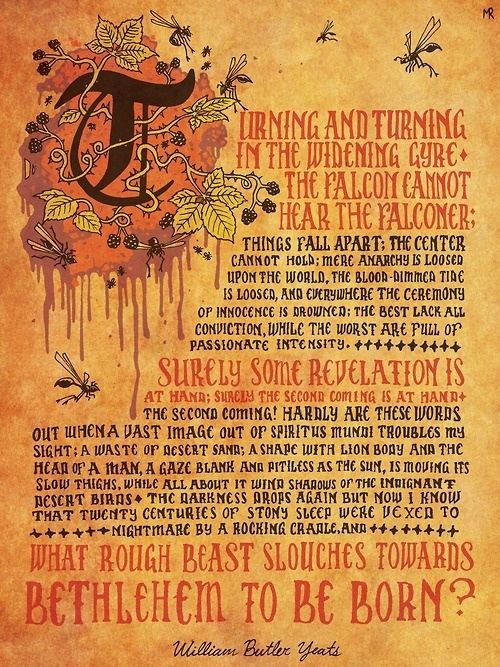Originally published 1919 | ||
 | ||
Similar W B Yeats books, Other books | ||
"The Second Coming" is a poem written by Irish poet W. B. Yeats in 1919, first printed in The Dial in November 1920, and afterwards included in his 1921 collection of verses Michael Robartes and the Dancer. The poem uses Christian imagery regarding the Apocalypse and Second Coming allegorically to describe the atmosphere of post-war Europe. The poem is considered a major work of Modernist poetry and has been reprinted in several collections, including The Norton Anthology of Modern Poetry.
Contents
Historical context
The poem was written in 1919 in the aftermath of the First World War and the beginning of the Irish War of Independence that followed the Easter Rising, at a time before the British Government decided to send in the Black and Tans to Ireland. Yeats used the phrase "the second birth" instead of "the Second Coming" in his first drafts.
Analysis
"The Second Coming" contains images that have been tied most closely to Yeats's legacy. Modernists read the poem as a dirge for the decline of European civilisation in the mode of Eliot, but later critics have pointed out that it expresses Yeats's apocalyptic mystical theories, and it is thus the expression of a mind shaped by the 1890s.
Yeats incorporates his ideas on the gyre—a historical cycle of about 2,000 years. He first published this idea in his writing A Vision which predicted the expected anarchy that would be released around 2,000 years after the birth of Christ. The gyre suggests the image of a world spinning outward so that it cannot recall its own origin. These anxieties are closely tied to the traumas of a continent at war, and the rise of industrialism and militarism on a global scale.
The concluding lines refer to Yeats's belief that history was cyclical, and that his age represented the end of the cycle that began with the rise of Christianity; according to one interpretation, "the beast" referred to the traditional ruling classes of Europe who were unable to protect the traditional culture of Europe from materialistic mass movements.
This poem marks the transition into Yeats's final period in which he muses on the role of the poet at the closing of an era. He returns to earlier themes of mysticism, turning inward, asking questions about the self, mortality, and legacy, as exemplified by his collection, The Tower.
Influence
Phrases and lines from the poem are used in many works. Several novels, songs, TV episodes, and albums draw their title from "The Second Coming" (e.g. Chinua Achebe's 1958 novel Things Fall Apart and Joan Didion's 1968 essay collection Slouching Towards Bethlehem). A 2016 analysis by Factiva showed that lines from the poem have been quoted more often in the first seven months of 2016 than in any of the preceding 30 years in the context of political turmoil after Brexit referendum and President Donald Trump election with commentators repeatedly invoking its lines: “Things fall apart; the center cannot hold."
